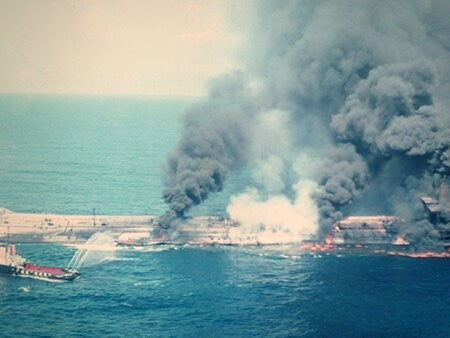Fire on the Water: The Atlantic Empress Oil Spill of 1979
Ashton Routhier
Share
A Collision in the Dark
On July 19, 1979, during a heavy tropical rainstorm off the coast of Tobago in the Caribbean Sea, two massive oil supertankers crossed paths in the worst possible way.
The Atlantic Empress—fully loaded with crude oil from Saudi Arabia—and the Aegean Captain, also carrying oil, collided in the night. Poor visibility, stormy seas, and last-minute course corrections set the stage for disaster.
At 7:15 p.m., the two tankers struck each other. The Atlantic Empress tore into the Aegean Captain’s starboard bow, igniting fires on both ships. For the crews, the collision marked the beginning of a fight for survival.
A Disaster Unfolds
Both vessels caught fire immediately. Explosions erupted. Crew members from both ships abandoned their posts as flames engulfed the decks. In total, 26 crew members from the Atlantic Empress lost their lives, along with one sailor from the Aegean Captain.
The Aegean Captain’s fires were brought under control quickly. The ship was towed to Curaçao, where it offloaded its remaining cargo with minimal additional leakage.
The Atlantic Empress was not so lucky.
Her fire burned for nearly two weeks, defying attempts by salvage teams to contain the flames. Dutch and German salvage experts attempted to control the inferno while two tugboats towed the still-burning vessel further out to sea—first 10 miles offshore, then 300 miles into deeper waters.
The Largest Ship-Based Oil Spill in History
On August 3, 1979, after a series of explosions, the Atlantic Empress finally sank beneath the waves, leaving behind a spill of 287,000 metric tonnes of crude oil. At the time, it became the largest ship-based oil spill ever recorded, a distinction it still holds today.
By comparison, the Exxon Valdez spill in 1989—which is far better known—released about 37,000 tonnes of oil, a fraction of the Empress disaster.
An Environmental Mystery
Despite the scale of the spill, the Atlantic Empress disaster remains one of the least studied oil spills in modern history. No comprehensive environmental impact assessments were conducted. Scientists still do not know:
- How much of the oil burned in the fire
- How much evaporated
- How much sank to the seafloor
- How much drifted across the Caribbean currents
Minimal shoreline pollution was reported at the time, likely because much of the oil was dispersed at sea. But without studies, the long-term ecological consequences remain unknown.
Why the World Forgot
Just one month earlier, in June 1979, the Ixtoc I oil well blowout had already begun pouring millions of gallons of crude oil into the Gulf of Mexico. The public’s attention was focused there. Media coverage of the Atlantic Empress collision was limited, and because no major tourist beaches or populated coastlines were visibly affected, the disaster quietly faded from headlines.
As Wes Tunnell, Associate Director of the Harte Research Institute for Gulf of Mexico Studies, later put it:
“If it’s not in a popular place and there’s not a huge outcry from the people that live in the area, probably not much is going to happen.”
That sentiment proved true. The Atlantic Empress spill became an ecological mystery washed away by the waves and forgotten by most of the world.
Lessons and Legacy
The Atlantic Empress disaster raised serious questions about the vulnerabilities of supertanker transport, especially in high-risk weather conditions. The collision led to calls for improved marine traffic management, better radar systems, and stricter safety protocols during storms.
Yet unlike later disasters such as the Exxon Valdez or Deepwater Horizon, the Atlantic Empress spill did not reshape environmental policy or corporate accountability. Its greatest legacy may be the cautionary reminder that some disasters disappear from public view—but their effects do not disappear from the ocean.
Today, the Caribbean still carries that oil somewhere—in its sediments, its deep waters, or scattered across its food webs. We may never fully know.
